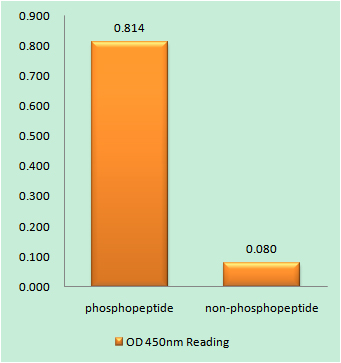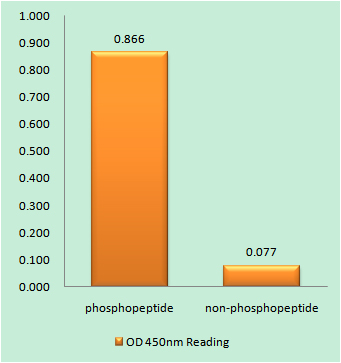Phospho ZAP-70 (Y493) Cell-Based Colorimetric ELISA Kit
- Catalog No.:KA1675C
- Applications:ELISA
- Reactivity:Human;Mouse;Rat
- Gene Name:
- ZAP70
- Human Gene Id:
- 7535
- Human Swiss Prot No:
- P43403
- Mouse Swiss Prot No:
- P43404
- Storage Stability:
- 2-8°C/6 months
- Other Name:
- Tyrosine-protein kinase ZAP-70 (EC 2.7.10.2) (70 kDa zeta-chain associated protein) (Syk-related tyrosine kinase)
- Detection Method:
- Colorimetric
- Background:
- catalytic activity:ATP + a [protein]-L-tyrosine = ADP + a [protein]-L-tyrosine phosphate.,disease:Defects in ZAP70 are the cause of selective T-cell defect (STD) [MIM:176947]. STD is an autosomal recessive form of severe combined immunodeficiency characterized by a selective absence of CD8-type T-cells.,domain:The SH2 domain binds to the phosphorylated tyrosine-based activation motif (TAM) of CD3Z.,function:Plays a role in T-cell development and lymphocyte activation. Essential for TCR-mediated IL-2 production. Isoform 1 induces TCR-mediated signal transduction, isoform 2 does not.,online information:ZAP70 mutation db,PTM:Phosphorylated on tyrosine residues upon T-cell antigen receptor (TCR) stimulation. Tyr-319 phosphorylation is essential for full activity.,similarity:Belongs to the protein kinase superfamily. Tyr protein kinase family. SYK/ZAP-70 subfamily.,similarity:Contains 1 protein kinase domain.,similarity:Contains 2 SH2 domains.,subcellular location:After antigen stimulation, isoform 1 concentrates at the immunological synapse and isoform 2 remains cytoplasmic.,subunit:Interacts with SLA2 when it is phosphorylated. Interacts with CD3Z and with phosphorylated NFAM1. Interacts with CBLB (By similarity). Interacts with CBL and SLA when it is phosphorylated. The association with SLA (or SLA2) and CBL probably leads to its destruction. Interacts with SHB. Interacts with DEF6 (By similarity). Interacts with FCRL3.,tissue specificity:Expressed in T- and natural killer cells.,
- Function:
- cell activation, activation of immune response, immune response-activating cell surface receptor signaling pathway,immune system development, leukocyte differentiation, positive regulation of immune system process, regulation of leukocyte activation, positive regulation of leukocyte activation, immune response-activating signal transduction,immune response-regulating signal transduction, immune response-regulating cell surface receptor signaling pathway,protein amino acid phosphorylation, phosphorus metabolic process, phosphate metabolic process, immune response,cell surface receptor linked signal transduction, intracellular signaling cascade, protein kinase cascade, positive regulation of cell proliferation, positive regulation of signal transduction, positive regulation of cell communication,phosphorylation, peptidyl-tyrosine phosphorylation, peptidyl-tyrosine modification, hemopoiesis
- Subcellular Location:
- Cytoplasm . Cell membrane ; Peripheral membrane protein . In quiescent T-lymphocytes, it is cytoplasmic. Upon TCR activation, it is recruited at the plasma membrane by interacting with CD247/CD3Z. Colocalizes together with RHOH in the immunological synapse. RHOH is required for its proper localization to the cell membrane and cytoskeleton fractions in the thymocytes (By similarity). .
- Expression:
- Expressed in T- and natural killer cells. Also present in early thymocytes and pro/pre B-cells.
- June 19-2018
- WESTERN IMMUNOBLOTTING PROTOCOL
- June 19-2018
- IMMUNOHISTOCHEMISTRY-PARAFFIN PROTOCOL
- June 19-2018
- IMMUNOFLUORESCENCE PROTOCOL
- September 08-2020
- FLOW-CYTOMEYRT-PROTOCOL
- May 20-2022
- Cell-Based ELISA│解您多样本WB检测之困扰
- July 13-2018
- CELL-BASED-ELISA-PROTOCOL-FOR-ACETYL-PROTEIN
- July 13-2018
- CELL-BASED-ELISA-PROTOCOL-FOR-PHOSPHO-PROTEIN
- July 13-2018
- Antibody-FAQs


